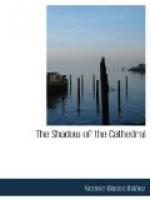Humanities, theology, canons, everything, the young man mastered with an ease which surprised his masters, and they compared him to the Fathers of the Church, who had attracted attention by their precocity. He would very soon finish his studies, and they all predicted that his Eminence would give him a professorship in the seminary, even before he sang his first mass. His thirst for learning was insatiable, and it seemed as though the library really belonged to him. Some evenings he would go into the Cathedral to pursue his musical studies, and talk with the Chapel-master and the organist, and at other times in the hall of sacred oratory he would astound the professors and the Alumni by the fervour and conviction with which he delivered his sermons.
“He is called to the pulpit,” they said in the Cathedral garden. “He has all the fire of the apostles; he will become a Saint Bernard or a Bossuet. Who can tell how far this youth will go, or where he will end?”
One of the studies which most delighted Gabriel was that of the history of the Cathedral, and of the ecclesiastical princes who had ruled it. All the inherent love of the Lunas for the giantess who was their eternal mother surged up in him, but he did not love it blindly as all his belongings did. He wished to know the why and the wherefore of things, comparing in his books the vague old stories that he had heard from his father, that seemed more akin to legends than to historical facts.
The first thing that claimed his attention was the chronology of the archbishops of Toledo—a long line of famous men, saints, warriors, writers, princes, each with his number after his name, like the kings of the different dynasties. At certain times they had been the real kings of Spain. The Gothic kings in their courts were little more than decorative figureheads that were raised or deposed according to the exigencies of the moment. The nation was a theocratic republic, and its true head was the Archbishop of Toledo.
Gabriel grouped the long line of famous prelates by characters. First of all the saints, the apostles in the heroic age of Christianity, bishops as poor as their own people, barefooted, fugitives from the Roman persecution, and bowing their heads at last to the executioner, firm in the hope of gaining fresh strength to the doctrine for which they sacrificed their lives—Saint Eugenio, Melancio, Pelagio, Patruno and other names that shone in the past scarcely breaking through the mists of legend. Then came the archbishops of the Gothic era; those kingly prelates who exercised that superiority over the conquering kings by which the spiritual power succeeded in dominating the barbarian conquerors. Miracles accompanied them to confound the Arians, and celestial prodigies were at their orders to terrify and crush those rude men of war. The Archbishop Montano, who lived with his wife, and was indignant at the consequent murmurs, placed red-hot coals in his sacred vestments




